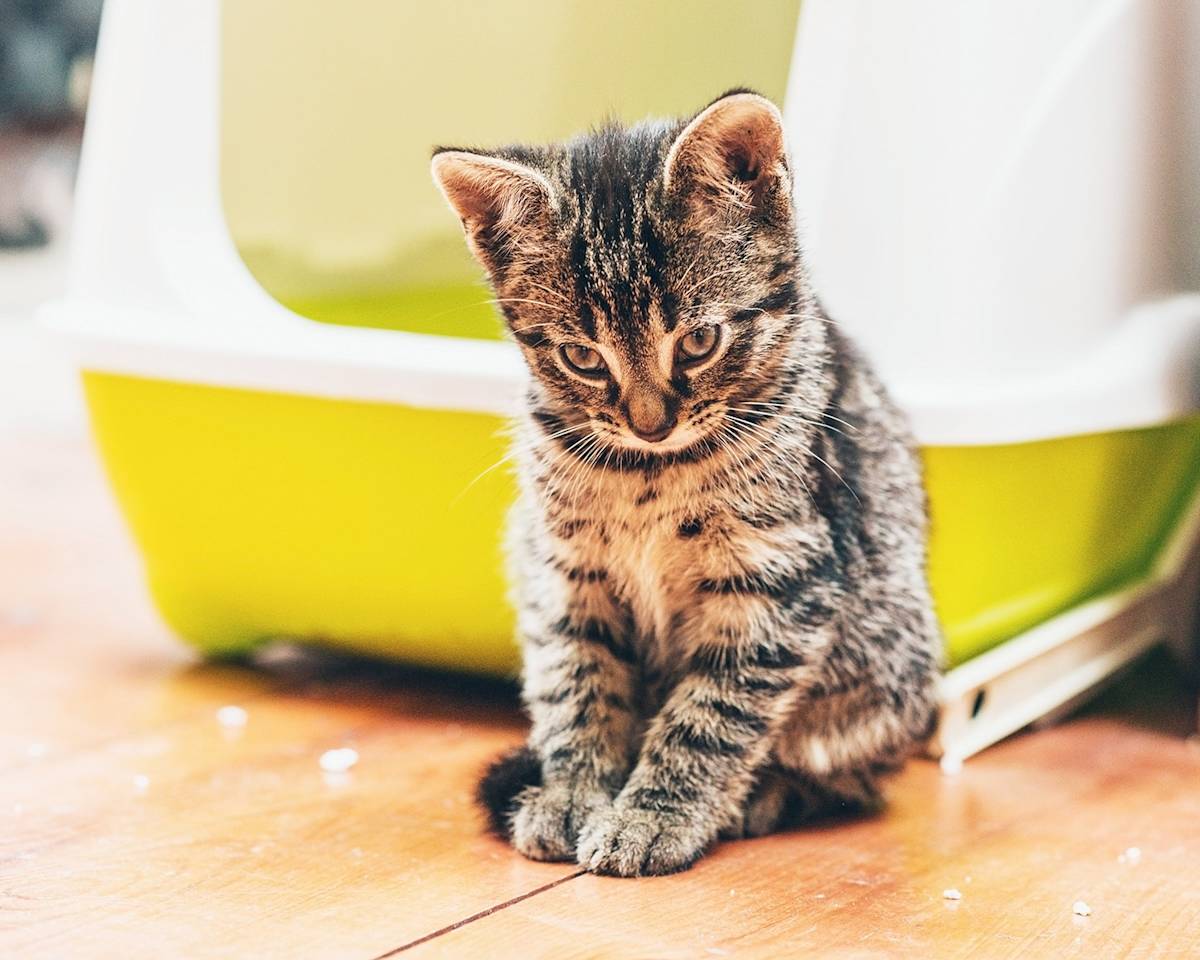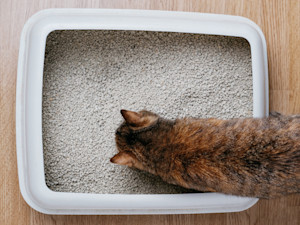Why Is My Cat Spraying Inside the Litter Box?
Are they marking their territory in their toilet?

Share Article
If you’ve ever discovered your cat spraying inside their litter box, you’re not the only one – it’s more common than you might think.
It can be embarrassing – nothing quite like guests dropping in and your home smelling like a festival port-a-loo. Maybe a little impressive – how did they manage to aim that high? But also bewildering – is it just peeing if it’s happening in the ‘right’ place? Perhaps you thought spraying was a sexual behaviour only performed by un-neutered cats. You might know that neutered cats spray outdoors on fences and bushes – completely normal behaviour – and may spray on walls, doors and furniture when stressed. So when they choose the litter box as their target, it feels like a complete curveball. Whatever you’re thinking, you’re probably feeling overwhelmed.
The good news? Spraying inside the tray is usually fixable, once you figure out what’s motivating it. Let‘s dive in.
Spraying versus weeing – what’s the difference?
First, you need to define exactly what’s happening. Not all wee is created equal. Cat spraying versus urinating are two entirely different behaviours, though they can look deceptively similar.
When a cat urinates, they typically squat low to the ground and release a large volume of urine, aiming directly onto the litter. This is straightforward elimination. Spraying (marking) is about communication rather than taking a bathroom break. A spraying cat will stand upright, tail raised and often quivering, backing up to a vertical surface and releasing a small amount of urine. This is sometimes accompanied by treading their hind feet. They’re not relieving themselves – they’re sending a message.
Now here’s where it gets complicated – some cats are just high pee-ers. They’re not spraying to mark the tray, they’re just anatomically or behaviourally inclined to semi-squat or stand mid-pee. As a result, the urine ends up on the side of the box or splashes over the edge. It’s easy to misinterpret.
Why would a cat spray inside the litter box?
It feels counterintuitive, doesn’t it? Spraying is a marking behaviour meant to be seen and smelled. So why do it in the toilet? There are a couple of reasons:
Territorial stress
Approximately ten percent of neutered males and five percent of spayed females sprayopens in new tab. The presence of unfamiliar cats outside is a common trigger, particularly if the litter box is positioned next to a cat flap, window or patio doors, giving the kitty intruder a clear view of your cat when they are toileting. Your cat feels vulnerable and is saying, “I know I’m supposed to go here, but I also need to mark this space, as I don’t feel safe.”
Cats can coexist harmoniously in a multi-cat household and even become besties, but that doesn’t mean they’ll be happy to share resources. If there’s tension (even low-level) and perceived or actual competition, some cats may respond by spraying inside the litter box, letting their housemates know, “Hey, this box is mine.”
Medical causes
Pain or discomfort can lead to odd behaviour in the litter box. A urinary tract infection, inflammation (eg stress cystitis), struvite crystalsopens in new tab, or bladder stones can cause your cat to strain to pass urine. While straining, they may unintentionally assume a more upright position, causing urine to spray upward.
Osteoarthritis is another common culprit. About 40 percent of all cats display clinical signsopens in new tab, and over 90 percent of cats over 12 years of age show radiographic evidence of the diseaseopens in new tab. Painful, stiff joints can make it difficult or uncomfortable for a cat to squat, particularly on hard, pelleted litter (the equivalent of us trying to squat to pee while balancing on Lego bricks).
Anxiety
Cats are at their most vulnerable when going to the toilet. Any perceived threat – another cat blocking or ambushing them, a loud noise or even a curious toddler – can cause anxiety. Covered boxes exacerbate this by making them feel trapped. Add in any disruptions to their routine – a house move, building work, a new roommate, baby or pet – and that sense of security gets even shakier. Some cats cope by weeing standing up, poised to bolt to safety; others spray inside the box as an attempt to self-soothe and cope with their emotional arousal.
Litter box aversion
In some cases, it’s the box that’s the problem. If your cat is unhappy with the position, setup or cleanliness of their facilities, it can affect their toileting habits. Common offenders are litter boxes that are too small for them to move around in comfortably, covered boxes, the wrong type of litter, not enough boxes, dirty boxes and boxes located in high-traffic, noisy or overlooked locations.
Reading the signs
A normal routine is squat low, pee, cover and walk away. If your cat’s bottom starts rising mid-pee, or they stand, tail raised, and start spraying from the outset, it could be urination or spray marking – the scent, volume of urine and frequency are telling.
Unless your cat has a medical issue, regular pee is less pungent than spray. Urine spray often has a distinctive ammonia-like odour with a musky undertone, which lingers much longer than regular urine. The intensity of the scent is due to the composition of the spray – urine is normally a combination of water and waste products. Spray contains a higher concentration of chemical compounds, which make it smell more potent, including fatty acids and pheromones, which are designed to mark territory, attract a mate or express fear or stress.
The amount of urine deposited during spray marking is less than two millilitresopens in new tab. A large volume of spray, or a combination of a puddle of urine in the litter with a small amount of spray on the box, indicates postural dysfunction or that your cat has been interrupted mid-flow rather than during true spraying behaviour.
Cats normally urinate between two and four times a day, so if your cat is constantly in and out of the box, that’s a red flag for a urinary issue or a high level of stress.
What you can do (yes, you can fix this)
Don’t panic. You’re not doomed to a life spent wiping pee off the litter box and floor. This is solvable.
Any time you notice a change in your cat’s toileting behaviour, your first stop should be the vet. A physical examination and urinalysis will rule out underlying medical conditions that may be causing or contributing to your cat’s behaviour.
If they’re physically fine, upgrade their toilet experience. A few key tips:
Litter boxes should be at least one and a half times the length of your cat – look for those marked ‘extra large’ or ‘jumbo’.
Most cats prefer an uncovered box for visibility and airflow.
Avoid plastic liners that snag claws.
Choose an unscented, fine, sandy-textured, clumping litter.
Fill the box to a depth of three to four centimetres.
Scoop twice a day, and wash the box weekly with hot water and an unscented pet-safe detergent.
Provide one litter box per cat, plus one extra, and distribute them throughout the house in private, low-traffic areas with good sight-lines.
If your cat has been a stand-up pee-er since kittenhood, accept that this is one of their unique quirks and manage the situation by switching to a high-sided litter box or DIY one by cutting an entrance into a large, tall, clear plastic storage container (smooth any sharp edges).
Not all inter-cat conflict involves fur-flying brawls. Social stress can be subtle. Staring contests, silent stalking, and resource guarding can all create tension. Ensure every cat has their own, separated resources. Prioritise vertical space and escape routes, so cats can avoid each other, and intervene to prevent agonistic encounters.
Use pheromone diffusers to reduce overall stress and increase your cat’s sense of safety and security. Interactive play with wand toys and foraging from food puzzles can release feel-good endorphins, reducing stress and increasing confidence. Keep a consistent routine to give your cat a sense of predictability and control. Don’t scold them if they spray inside the litter box. Verbal reprimands can cause fear and anxiety, making the problem worse and damaging your cat’s trust in you.
If spraying persists despite your best efforts, consult a qualified cat behaviourist. Sometimes, a professional perspective is the final piece of the puzzle.
You’re not a bad cat parent
If your cat is spraying in the litter box, it’s easy to feel like you’ve done something wrong or that your cat is making a dirty protest. But this isn’t a personal failure, and your cat isn’t being difficult or trying to punish you. With some detective work, environmental adjustments, and perhaps some support from your vet or behaviourist, things will get better. Your cat is just trying to communicate with you the only way they know how, and now you’re listening.
References
Cannon, M. (2024). Current insights into feline osteoarthritisopens in new tab. Companion animal, 29(3), pp.22–28. doi:https://doi.org/10.12968/coan.2023.0070.
Heath, S. (2000). Marking in the Catopens in new tab. Veterinary Nursing Journal, 15(2), pp.57–58. doi:https://doi.org/10.1080/17415349.2000.11013027.
Horwitz, D.F. (2019). Common feline problem behaviors: Urine sprayingopens in new tab. Journal of Feline Medicine and Surgery, 21(3), pp.209–219. doi:https://doi.org/10.1177/1098612x19831203.
Mills, D.S., Redgate, S.E. and Landsberg, G.M. (2011). A Meta-Analysis of Studies of Treatments for Feline Urine Sprayingopens in new tab. PLoS ONE, 6(4), p.e18448. doi:https://doi.org/10.1371/journal.pone.0018448.
Veterinary Ireland Journal. (2021). Osteoarthritis in catsopens in new tab. [online] Available at: https://www.veterinaryirelandjournal.com/focus/225-osteoarthritis-in-cats.

Claire Stares, BA (Hons), MA, PG Dip Clinical Animal Behaviour
Claire Stares is a feline behaviourist with a PG Diploma in Clinical Animal Behaviour from the University of Edinburgh Royal (Dick) School of Veterinary Studies. She’s dedicated to helping guardians and their cats overcome behavioural problems and thrive so that they can enjoy life together. A cat lady since babyhood (her first word was cat!), she has over 20 years of experience living and working with cats in homes, rescue environments and veterinary practices. A passionate advocate for training cats for enrichment and cooperative care, she practices what she preaches with her five cats: three rescued Domestic Shorthairs, Bimble, Bertie and Katie, a Siamese called Daisy Mae, and a Maine Coon named Horatio. When there isn’t a feline companion asleep on her laptop, she writes books and articles for various publications.
Related articles
![Picture of a grey cat sitting next to a wet patch on a beige carpet]()
10 Reasons Why Your Cat Isn’t Using the Litter Tray
Not on the couch... again
![Birds Eye view of a cat on the edge of a litter tray]()
Yes, You Can Train an Older Cat to Use a Litter Tray
No more accidents here
![A woman petting her cat on the couch]()
6 Surprising Signs of Arthritis in Cats
They’re not what you’d think, according to veterinary behaviourist Dr Margaret Gruen
![two cats sharing litter box]()
Can Cats Share a Litter Box?
The better question is should they?




